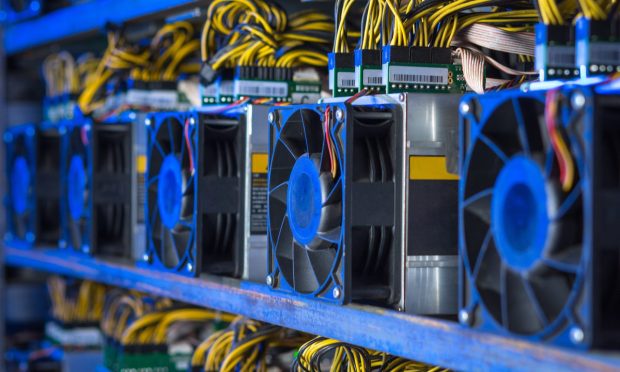Jack Dorsey’s Block Wants to Return Bitcoin Mining to the Masses

Block CEO Jack Dorsey sees a big problem in crypto and he’s building an open-source solution to fix it.
In this case, the problem is bitcoin mining. Specifically, that it is so difficult and expensive that in large part only well-funded mining pools can do it.
Case in point: Earlier this week, a solo bitcoin miner won the race to write a new block of transactions onto the bitcoin blockchain, gaining the 6.25 BTC block reward — worth about $260,000 at the time. That was a 1-in-1.37 million shot — and unusual enough to make several leading crypto news outlets.
So, there’s a fairness angle, but more importantly, for bitcoin mining to remain a community rather than an oligarchy, the community must be able to participate meaningfully. The last time a solo miner won the race was on Dec. 2.
Dorsey’s answer is to have Block — the payments company formerly known as Cash App parent Square — produce a readily available and efficient mining rig and easy-to-use software to run it. He talked about it back in October and on Jan. 13 announced on Twitter, “We’re officially building an open bitcoin mining system.”
The first point Dorsey made back in October was the need to open bitcoin mining back up to the mases, as its pseudonymous creator Satoshi Nakamoto intended.
“Mining needs to be more distributed,” Dorsey said. “The core job of a miner is to securely settle transactions without the need for trusted 3rd parties. This is critical well after the last bitcoin is mined. The more decentralized this is, the more resilient the Bitcoin network becomes.”
That’s vital, because decentralization is the core mechanic of all blockchain technology.
Blockchain transactions are secured through cryptography, but the blockchain itself is secure because many copies of it exist, distributed around the world. Anyone can set up a node fairly easily, and blockchains ensure the accuracy of each block of transactions by updating all nodes at once. Any node that does not agree is booted off into a fork — essentially a new blockchain. That means that — once a blockchain reaches a critical mass of well-distributed nodes — it is free from government censorship.
Block’s general manager of hardware, Thomas Templeton made that point in a Jan. 13 Twitter thread describing the goals of project.
“We want to make mining more distributed and efficient in every way, from buying, to set up, to maintenance, to mining,” he said. “We’re interested because mining goes far beyond creating new bitcoin. We see it as a long-term need for a future that is fully decentralized and permissionless.”
Fixing Mining
The mining rigs would feature custom-designed chips, software primarily designed in-house at Block but open-source. Anyone would be free to build the hardware and software.
It would be, Dorsey said last year, “based on custom silicon and open source for individuals and businesses worldwide. If we do this, we’d follow our hardware wallet model: build in the open in collaboration with the community.”
Over the next three months, Templeton said, Block looked at the pain points keeping people from mining.
One was availability. With mining rigs competing with gaming computers and systems for chips, mining computers could be hard to get without being able to place a multi-million-dollar order — even before the pandemic disrupted the silicon supply chain.
Second was reliability, with current systems needing time-consuming reboots “almost every day” Templeton said. Third was performance: Bitcoin ASIC machines are loud and very power-hungry. Fixing that requires a balance between performance and usability, he added.
Besides, the mining software is often very complex for non-techies. Think of it as running a Linux OS on your home computer.
“Bitcoin mining should be as easy as plugging a rig into a power source,” Templeton said. “There isn’t enough incentive today for individuals to overcome the complexity of running a miner for themselves.”
Dorsey is a believer in open-source projects and willing to put his corporate money where his mouth is. As CEO of Twitter, he launched BlueSky, a project funded by the company to build an open-source, decentralized social network protocol. Essentially a community-governed open platform for social media companies — including Twitter — to build on that.
One part of the project, announced in 2019 when banning politicians from platforms including Facebook and Twitter was becoming a huge issue, was customizable and decentralized (DAO-governed) moderation and algorithms designed to avoid reinforcing controversy. How it will fare under new leadership is questionable, to say the least.
Read more: PYMNTS DeFi Series: Unpacking DeFi and DAO
Security Concerns
There is even a — mostly theoretical — security concern in the effective inability of individuals to mine for bitcoin.
Most of the mining hashrate —the total combined computational power of a blockchain’s miners — in the hands of two groups in bitcoin: A few companies that can afford server farms of five-figure custom-designed ASIC mining computers and the enormous power bill they rack up, and pools, in which small miners pool their hash power and rewards.
And that’s a problem. Even a security risk.
Blockchain has one big weakness: If someone controls more than 51% of the hash power used to mine bitcoins, they can take control of the blockchain, and double-spend incoming transactions. It’s not theoretical. The Ethereum Classic blockchain, with a market capitalization of $4.2 billion, suffered three successful 51% attacks in August 2020. Hackers made off with $9 million.
See also: The 51% Attack: Crypto’s Double-Spending Achilles Heel
According to BTC.com, the four largest mining pools account for more than 59% of bitcoin’s hash power, and the top six 81%.
The threat is easy to overstate — among other things it’s widely believed that a successful 51% attack on bitcoin would crash its value so badly that the attackers would end up losers — but that’s a lot of centralization for a decentralized blockchain.